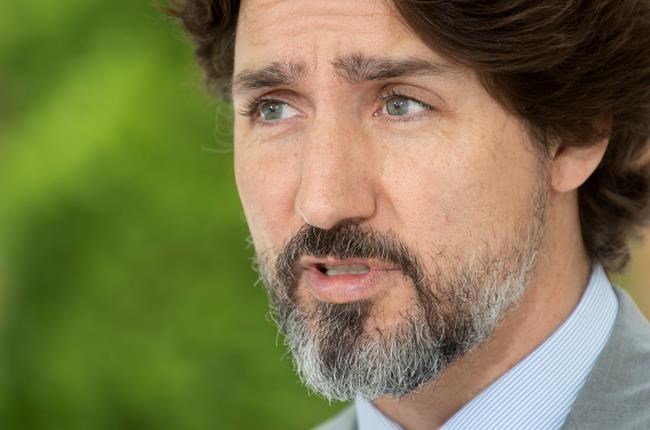New Canadian modelling shows COVID-19 waning but relaxing restrictions still risky
Advertisement
Read this article for free:
or
Already have an account? Log in here »
To continue reading, please subscribe:
Monthly Digital Subscription
$0 for the first 4 weeks*
- Enjoy unlimited reading on winnipegfreepress.com
- Read the E-Edition, our digital replica newspaper
- Access News Break, our award-winning app
- Play interactive puzzles
*No charge for 4 weeks then price increases to the regular rate of $19.00 plus GST every four weeks. Offer available to new and qualified returning subscribers only. Cancel any time.
Monthly Digital Subscription
$4.75/week*
- Enjoy unlimited reading on winnipegfreepress.com
- Read the E-Edition, our digital replica newspaper
- Access News Break, our award-winning app
- Play interactive puzzles
*Billed as $19 plus GST every four weeks. Cancel any time.
To continue reading, please subscribe:
Add Free Press access to your Brandon Sun subscription for only an additional
$1 for the first 4 weeks*
*Your next subscription payment will increase by $1.00 and you will be charged $16.99 plus GST for four weeks. After four weeks, your payment will increase to $23.99 plus GST every four weeks.
Read unlimited articles for free today:
or
Already have an account? Log in here »
Hey there, time traveller!
This article was published 04/06/2020 (2020 days ago), so information in it may no longer be current.
OTTAWA – Canada’s top doctor says the country has been successful at slowing the spread of COVID-19 but warns that relaxing public health restrictions too quickly or too soon could lead to a rampant resurgence of the disease.
Dr. Theresa Tam presented a new report on the novel coronavirus in Canada Thursday, including new short-term projections that say between 157 and 1,857 more Canadians could die of COVID-19 in the next 11 days.
The projections, based on recent trends, estimate in the best-case scenario at least another 4,459 people will be diagnosed with COVID-19 by June 15, and in the worst-case scenario there will be more than 14,000 new cases by then. What happens depends almost entirely on how well Canadians practise proper public health behaviours, and how good health systems are at testing, contact tracing and isolating positive cases.

“Without a vaccine or treatment, public health measures remain essential to control the epidemic,” said Tam.
Canada has been averaging just under 800 new cases a day for the last week, down from an average of 1,050 new cases the week before that.
Tam said most of the country has seen spread of the disease diminish substantially but there remain hot spots of community transmission in Toronto and Montreal that are concerning. In the last two weeks, Ontario and Quebec accounted for 90 per cent of new cases, and most of those were in those two cities.
Tam said the efforts Canada has made, including physical distancing and closures of businesses and public spaces, have allowed us to flatten the curve, but we can’t get cocky and think the worst is over so we can get back to normal now.
“Resurgence can actually occur at any time over the course of the outbreak depending on what we’re doing on the ground,” she said. “We mustn’t forget that.”
As of Thursday, Tam said, Canada has had 93,441 positive cases and 7,543 deaths. She said about 16 per cent of patients required hospitalization and three per cent needed to be admitted to intensive care.
The eight per cent death rate reflects the number of outbreaks in long-term-care homes — more than 80 per cent of patients who died are connected to long term care homes or seniors’ residences. But Tam said the rate must be viewed knowing the overall number of people who have had COVID-19 is not yet known, because lab-confirmed cases are “just the tip of the iceberg.”
Plans to test Canadians for antibodies to detect whether they have had the novel coronavirus will give a better sense of the true number of cases, Tam said.
The modelling also shows Canada has successfully reduced the reproductive rate — the number of additional people infected by a single person with COVID-19. This virus is highly infectious and in some parts of the world the rate was as high as five, meaning every person getting COVID-19 was passing it on to five more people.
In Canada, the rate peaked at just more than two, but the numbers show that began to decline sharply in the last week of March when the country went into strict lockdown in almost every province. Tam said the rate needs to be consistently below one for more than three weeks to be sure public health measures are working.
It has been below one most of the time since the beginning of May but the hotspots of community transmission in Toronto and Montreal are exceptions, said Tam.
Overall, the report says, with a high degree of physical distancing and case testing and tracing, Canadians can expect that the number of new cases will stay very low, including no real second wave in the fall.
With weaker controls, a surge of cases could see half of Canadians infected, with a rising number of cases throughout the summer and into next winter.
With no controls at all, as many as 80 per cent of Canadians will get infected by the end of the summer.
“It doesn’t take very long for an outbreak to really gain some steam,” said Health Minister Patty Hajdu.
Prime Minister Justin Trudeau said earlier Wednesday he is encouraged by the overall trends in Canada but warned the country is not out of the woods.
Clusters of cases of COVID-19 have disproportionately affected institutional settings including long-term care homes, hospitals, prisons and meat plants. Canada’s largest single outbreak is linked to the Cargill meat-processing plant in Alberta, with 1,560 cases including workers, their family members and others in their communities.
This report by The Canadian Press was first published June 4, 2020.


